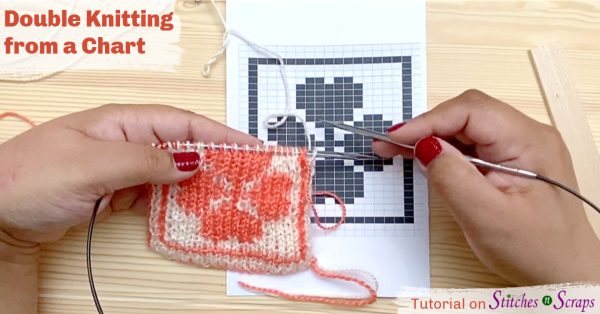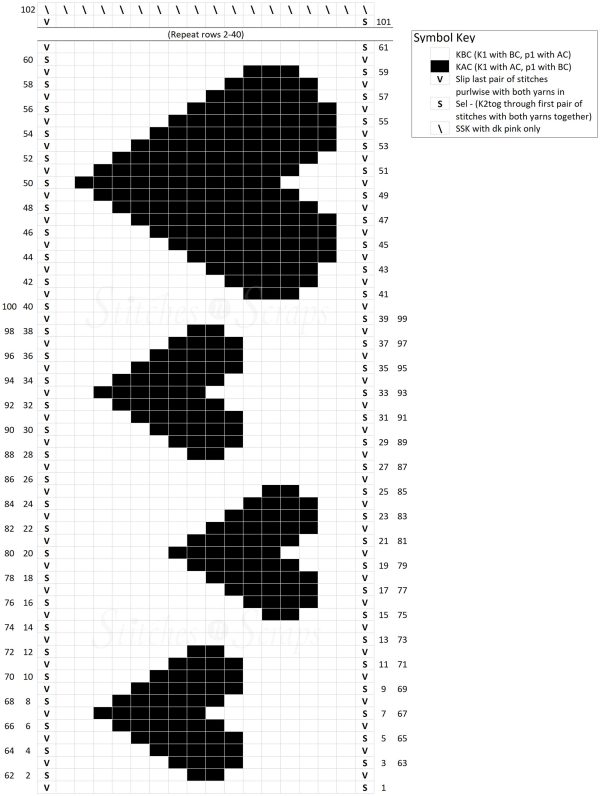Sweethearts Double Knit Ear Warmer Pattern
Warm your heart (and ears) with the Sweethearts Ear Warmer! This double knit ear warmer is worked flat and seamed, with a simple colorwork design. It’s a great introduction if you’re new to double knitting.

This content is protected by copyright. See this Terms of Use / Copyright page for more information.
This post contains sponsored content and/or affiliate links. If you click an affiliate link and make a purchase, I may get a commission.
What is Double Knitting?
Double knitting creates a double layer of fabric by using two working yarns at once. The stitches are worked in pairs, alternating between one “front layer” stitch and one “back layer” stitch. Since this is a stockinette pattern, you will knit the front layer stitches and purl the back layer stitches.
This is most often done as a colorwork technique with 2 different colors of yarn. Each side of the fabric ends up with the same design, but with the colors reversed.
Double Knit Edges
For any double knitting pattern that’s worked flat, you need to consider the cast on, bind off, and selvage edges.
Cast On and Bind Off
This double knit ear warmer pattern starts and ends with a single layer of garter stitch at the back. That means there’s no need to fuss with 2 colors for the cast on and bind off edges.

Instead, it starts with a provisional cast on using waste yarn. At the end, you will remove the waste yarn so you have live stitches on both ends. Then you can graft the two ends together with kitchener stitch.
The colorwork section has a second layer. You’ll use increases to add the 2nd color, and decreases to remove it.
Selvages
Since double knitting creates two layers of fabric, it’s important to tie those layers together at the selvage edges. One of the easiest ways to do this is to work the edge stitches of both colors together, as though they are just 1 stitch.
In addition, double knitting creates a stockinette-type fabric. So just like with a normal stockinette fabric, we can knit the first stitch and slip the last stitch of each row to create a smoother edge.

Putting these two considerations together, we knit the first stitch with both colors together as one, and we slip the last stitch of both colors on each row. This gives us a decorative, two color edge.
Reading the Double Knitting Chart
Each square on the chart represents two stitches – a knit on the front layer of the fabric, and then a purl on the back layer. Whichever color you use to knit will show on the side you are currently looking at. White squares on the chart mean to knit with the background color, and then purl with the accent color. Black squares mean to knit with the accent color and purl with the background color.

Remember that the colors are reversed on each side, so your background color on one side is your accent color on the other side and vice versa. This is why the chart refers to background and accent colors rather than the specific color.
There is no specific right or wrong side. Work odd-numbered rows starting from the right edge of the chart, and even-numbered rows starting from the left edge.
For a much closer look at working from double knitting charts, including a video, check out my double knitting from a chart tutorial. The selvage edges are treated a bit differently in that tutorial, but the rest is the same.
Choosing a Yarn
For the sample, I used Paintbox Aran acrylic yarn leftover from my Cotton Candy Stripes Scarf pattern. The colors are Bubblegum Pink and Candyfloss Pink. The more contrast you have between your colors, the more the double knit pattern will show on your ear warmer. You may find it helpful to take a grayscale picture of the yarns to see the contrast better.
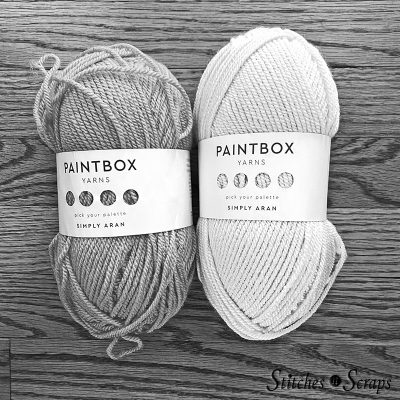
Superwash wool or acrylic yarns should work well for this pattern. Wool that is not superwash may felt a bit with use, and plant fibers like bamboo or cotton may stretch with use.
Materials
- Yarn: Worsted weight yarn
- 55 [60] yds dark pink
- 55 [60] yds light pink
- 5 yds waste yarn for cast on.
- Needles: Size 8 / 5 mm needles or size needed to match gauge
- Notions: Yarn needle
Project Level
Intermediate: Provisional cast on, increases and decreases, double knitting, grafting garter stitch.
Size
Small [Large]: Instructions are shown for size small, with large listed in [ ]
| Size | To fit head circumference | Length before seaming |
|---|---|---|
| Small | 21-23 inches | 19.25 inches |
| Large | 22-24 inches | 20.25 inches |
Your finished ear warmer should be about 2-4 inches smaller than the head circumference. This is a stretchy project so there is some overlap in the sizing. The size is easily adjustable in the last section of the pattern, so you can make it exactly as snug or loose as you want.
Gauge
14.5 sts x 24 rows = 4 inches in stockinette stitch. Use pattern as gauge swatch – after row 24, double knitting section of work should measure about 5 inches x 4 inches.
Abbreviations used
AC = accent color of the side you are working on
BC = background color of the side you are working on
k = knit
KAC = Knit accent color (see Special Stitches)
KBC = Knit background color (see Special Stitches)
kfb = knit front and back
p = purl
RS = right side
sel = Selvage stitch (see Special Stitches)
sl = slip purlwise with both yarns in front.
ssk = slip slip knit
st(s) = stitch(es)
WS = wrong side
Recommended Resources
- Sweethearts Ear Warmer Tutorial
- How to Knit a Provisional Cast On with a Crochet Hook from Nimble Needles
- Kfb Increase – How to Knit Front and back
- Double Knitting from a Chart – Reversible Colorwork
- Slip Slip Knit (ssk) Decrease Tutorial
- Knit 2 Together (k2tog) Tutorial
- How to Graft Garter Stitch from Edie Eckman
Special Stitches
- Knit background color (KBC): K1 in BC, bring both yarns to the front, p1 in AC, bring both yarns to the back.
- Knit accent color (KAC): K1 in AC, bring both yarns to the front, p1 in BC, bring both yarns to the back.
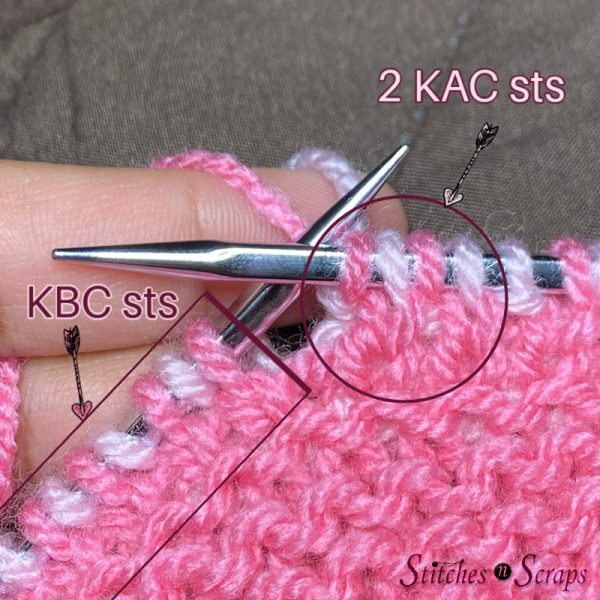
- Selvage stitch (Sel): With both yarns held together as one, k2tog through first pair of stitches. It does not matter which order the colors are in on the needle because these two stitches will always be worked or slipped together.

Instructions
Garter stitch starting section
I’ve designated odd numbered rows as RS rows for simplicity of instructions only – there is no real right or wrong side.
Cast on 12 stitches with waste yarn.
Rows 1-2: With dark pink, k across. (12 sts)
Row 3 (RS): K1, kfb, k to last 2 sts, kfb, k. (14 sts)
Row 4: K across (14 sts)
Rows 5-6: Repeat rows 3-4. (16 sts)
Row 7: Repeat row 3. (18 sts)
Set up for double knitting
Row 8: *K1 with dk pink but do not remove the stitch you worked into from the needle. With light pink, ktbl in same st and remove that stitch from the needle. Repeat from * across. (36 sts)

Double knit pattern section
Stitches are worked in pairs of 1 background color stitch and 1 accent color stitch. Because the pattern is reversible, the background and accent colors will be different for the two sides.
On RS rows the background color is light pink and the accent color is dark pink. On WS rows it is reversed. BC and AC always refer to the side you are currently working on.
See Special Stitches section for stitch definitions.
Row 1 (RS): Sel, KBC across to last pair of sts, sl last pair of sts.
Heart 1
Row 2: Sel, KBC 7, KAC 2, KBC 7, sl last pair of sts.
Row 3: Sel, KBC 6, KAC 4, KBC 6, sl last pair of sts.
Row 4: Sel, KBC 5, KAC 5, KBC 6, sl last pair of sts.
Row 5: Sel, KBC 6, KAC 6, KBC 4, sl last pair of sts.
Row 6: Sel, KBC 3, KAC 6, KBC 7, sl last pair of sts.
Row 7: Sel, KBC 8, KAC 6, KBC 2, sl last pair of sts.
Row 8: Repeat row 6
Row 9: Repeat row 5
Row 10: Repeat row 4
Row 11: Repeat row 3
Row 12: Repeat row 2
Rows 13-14: Sel, KBC across to last pair of sts, sl last pair of sts.
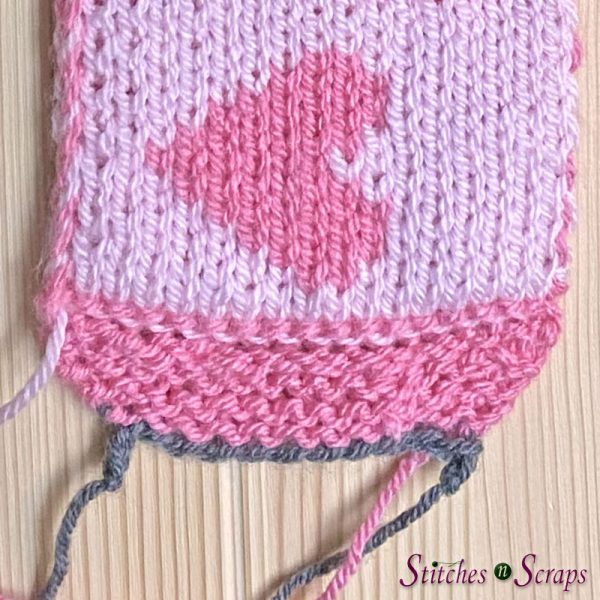
Heart 2
Row 15: Sel, KBC 3, KAC 2, KBC 11, sl last pair of sts.
Row 16: Sel, KBC 10, KAC 4, KBC 2, sl last pair of sts.
Row 17: Sel, KBC 2, KAC 5, KBC 9, sl last pair of sts.
Row 18: Sel, KBC 8, KAC 6, KBC 2, sl last pair of sts.
Row 19: Sel, KBC 3, KAC 6, KBC 7, sl last pair of sts.
Row 20: Sel, KBC 6, KAC 6, KBC 4, sl last pair of sts.
Row 21: Repeat row 19
Row 22: Repeat row 18
Row 23: Repeat row 17
Row 24: Repeat row 16
Row 25: Repeat row 15
Rows 26-27: Sel, KBC across to last pair of sts, sl last pair of sts.
Heart 3
Row 28-40: Repeat rows 2-14 of heart #1
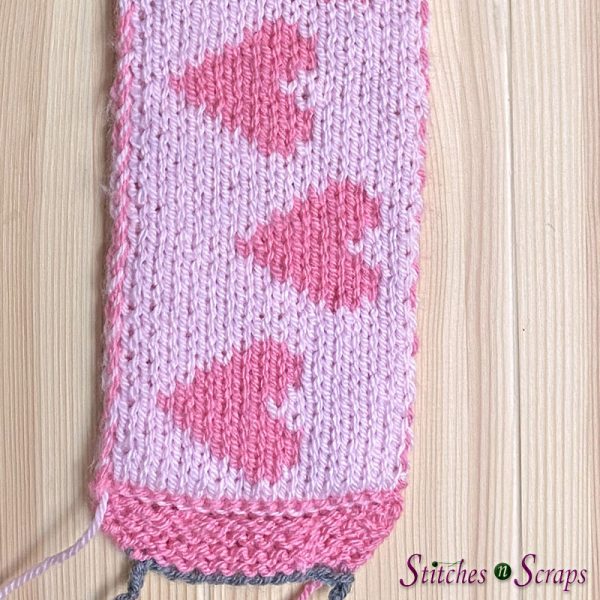
Heart 4 (big heart)
Row 41: Sel, KBC 3, KAC 3, KBC 10, sl last pair of sts.
Row 42: Sel, KBC 9, KAC 5, KBC 2, sl last pair of sts.
Row 43: Sel, KBC 2, KAC 6, KBC 8, sl last pair of sts.
Row 44: Sel, KBC 7, KAC 8, KBC 1, sl last pair of sts.
Row 45: Sel, KBC 1, KAC 9, KBC 6, sl last pair of sts.
Row 46: Sel, KBC 5, KAC 10, KBC 1, sl last pair of sts.
Row 47: Sel, KBC 1, KAC 11, KBC 4, sl last pair of sts.
Rows 48-49: Sel, KBC 3, KAC 11, KBC 2, sl last pair of sts.
Row 50: Sel, KBC 1, KAC 11, KBC 4, sl last pair of sts.
Rows 51-52: Repeat rows 48-49
Row 53: Repeat row 47
Row 54: Repeat row 46
Row 55: Repeat row 45
Row 56: Repeat row 44
Row 57: Repeat row 43
Row 58: Repeat row 42
Row 59: Repeat row 41
Rows 60-61: Sel, KBC across to last pair of sts, sl last pair of sts.
Hearts 5-7
Row 62-100: Repeat rows 2-40 of hearts 1-3.
Row 101: Sel, KBC across to last pair of sts, sl last pair of sts.
Cut light pink yarn only, leaving a tail to weave in later.

Row 102: With dark pink only, ssk through each pair of stitches across.
Garter stitch ending section
Decreasing
Row 1 (RS): K1, ssk, k across to last 3 sts, k2tog, k1 (16 sts)
Row 2: K across.
Rows 3-6: Repeat rows 1-2 twice more. (12 sts)
Working Even
K across for 1 [7] row(s).
Check the size of your ear warmer. If you need to adjust the size, you can add or remove rows in this working even section. Be sure to end after a RS row.

Seaming and Finishing
Carefully remove working yarn from cast-on edge and pick up the live stitches on your 2nd needle. Because you are actually picking up the loops between the stitches, you should have 11 stitches on your needle (not 12).
Make sure that both needles are pointing in the same direction when work is not twisted.

Hold the needles with RS together, and ending edge (the one with 12 stitches) in front. Graft / Kitchener stitch the live stitches from the starting and ending edges together.
Weave in all ends.

Rate this Double Knit Ear Warmer Pattern!
I hope you enjoyed this double knit ear warmer pattern.
A downloadable pdf of this pattern is available on Ravelry for a small fee. The fee for the pdf format is to offset the advertising revenue lost when you print or download the pattern rather than viewing it online.
Do you want the best of Stitches n Scraps delivered right to your inbox? Don’t miss a stitch – Subscribe now!




